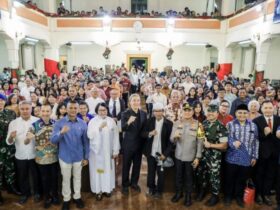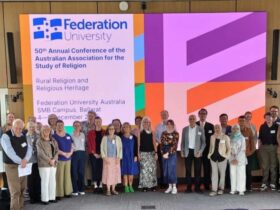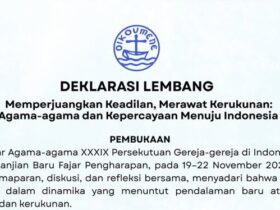Oleh: Afkar Aristoteles Mukhaer | Republikasi dari ICRS
Ringkasan:
● Institusi agama menampilkan kontradiksi dengan mendukung lingkungan secara tekstual tetapi terlibat dalam industri ekstraktif yang merusak.
● Komunitas rentan yang merasa dikhianati oleh institusi agama kini kembali berpegang teguh pada adat istiadat untuk keadilan ekologis.
● Masalah ekologi bersifat struktural, bukan sekadar moral.
Is religion always environmentally friendly? Religion has textual sources that teach interpreting them to preserve the environment and maintain a balance between human needs and nature. However, the reality is that religious groups are not united in their response to the ecological crisis. Religion has many facets—supporting vulnerable groups affected by extractive projects and promoting conservation, while simultaneously encouraging the operation of extractive projects that are harmful to the environment and surrounding communities.
This topic was the focus of the plenary session titled “Multi-faceted Religion and Ecological Crisis” held at the Auditorium of the UGM Graduate School, Yogyakarta, on October 23, 2025. The plenary session was part of the framework of the 7th International Conference and Consolidation on Indigenous Religions (ICIR), with the theme Ecocracy: Power to the People, Justice for All Planetary Community.
Religion disappoints, return to adat tradition
Jull Takaliuang described the situation in his hometown on Sangihe Island, located at the northern tip of Indonesia and bordering the Philippines. The social and economic justice of the Sangihe community has been neglected by the government, but only received attention during the General Election. As the director of Yayasan Suara Nurani Minaesa and an activist for Save Sangihe Island, Jull stated that gold mining remains an ongoing challenge. Sangihe is classified as a small island, so it has to be protected from extraction activities.
Sangihe has previously defeated mining threats. This victory was due to the support of the community, the Sangihe Regional Customary Agency, and religious authorities, who filed a lawsuit all the way to the Supreme Court. The Sangihe Talaud Evangelical Christian Church (GMIST) submitted two letters of recommendation expressing its theological stance against mining. The Communion of Churches in Indonesia (PGI) even wrote to President Joko Widodo, urging him to revoke and review the gold mining permit.
Nevertheless, mining challenges remain and are increasingly widespread in coastal areas, causing damage to the marine environment. The pressure faced by the community is also exacerbated by the involvement of law enforcement officials and the local government.
“I’m very sad and disappointed with the church. The pastor must listen. Although it’s only written down that they will fight, and there are sermons to save Sangihe, the GMIST Special Synod Session in September 2025 listed the extractive industry as one of the businesses that managed to generate revenue for the Church-Owned Enterprises,” said Jull. Yet, extractive industries, such as heavy metal mining, have impacted the ecosystem, food supply, and health of the Sangihe community.
“In the midst of our despair, where can we turn? There is no law, and religion has betrayed us. We met with the adat leader again. What can we do? Only adat doesn’t betray us.” Since then, the Sangihe community has resumed performing the dalumatehu sembanua ritual to maintain the balance of nature, seek ecological justice, and ask for protection and safety.
Dynamics of religious institutions in ecological issues
GPIB Pastor Jimmy M. I. Sormin did not deny Jull’s disappointment. Based on his observations, he found that religious groups are susceptible to being instrumentalized by donors and other institutions as project stakeholders rather than leading actors. That is what he mentioned as limited collaboration. Religious groups often become the objects and recipients of various aid projects, rather than implementing religious ecological knowledge about environmentalism.
“This limited collaboration leads to lies, as Jull mentioned earlier. The church’s stance supports environmental protection, but it also plays coy with extractive business actors,” said Jimmy.
The political and external tendencies of religious groups influence their responses to policies and the threat of ecological crises. This has led religious groups to become actors in the extractive industry and even demand a share of mining management.
Jimmy identified internal weaknesses in religious institutions that should be learned. First, differences in philosophy and bureaucracy within religious institutions mean that their decision-making chain requires a supreme authority with various theological and political considerations.
Furthermore, various religious institutions experience a generational gap, where younger groups like Millennials and Gen Z, who are ecologically conscious, are positioned as the next generation, not the ones who determine the future. Economic factors are a crucial weakness because they relate to the needs of the congregation, yet they are often used as an excuse by religious institutions. It indicates that religious institutions lack the capital for their justice movements, thus relying on extractive economic patterns.
The final weakness is a limited inclusive orientation. Religious institutions recognize coexistence and the need to collaborate, including with other religious institutions. However, this inclusion remains limited to working with local religions, indigenous communities, and other marginalized groups. Thus, religious groups have not yet become enablers of the movement for a “common home.”
The ‘corrupt’ face of religion
The ecological crisis is linked to corrupt perspectives, ethics, and actions. There is an imbalance in the management of natural resources and, on the one hand, the neglect of the carrying capacity or space of certain locations for resource extraction. While corruption is ubiquitous, not only in the economic sector but also in political action, religious groups also play a role in the ambivalence of ecological politics.
“The multifaceted nature of religion is not unique,” said Eko Cahyono of the Sajogyo Institute. Based on years of research, Eko revealed that this multifaceted phenomenon exists in other religious institutions, such as Islam, Hinduism, and Catholicism. The allocation of mining concessions to Nahdlatul Ulama and Muhammadiyah is one example of how Islam has fallen prey to the extraction industry. Religious figures in various places have also been instrumental in opening access to mining, as in the case of Maba Sangaji. On the other hand, other Islamic religious figures have opposed mining and environmental destruction to the point of being forced to flee.
Balinese Hindu groups are also divided between supporting and opposing the planned Benoa Bay reclamation project. Catholic leaders in Ende oppose geothermal energy, but the Maumere diocese is evicting indigenous communities.
There are many weak points beyond those mentioned by Jimmy, including differences in interpretation, the relationship between religion and state, the relationship between religion and capital, the politicization of religion, differences in the meaning of holy sites, and differences in the relationship between humans and nature. These, as Eko noted, serve as access points for corruption within religious institutions.
Corruption enters through political approaches, such as “pity corruption”, where Muslims are sent on the Umrah pilgrimage and Christians are taken on trips to Jerusalem, thus opening up access to mining permits. Religious figures also become advocates for “holy grabbing,” where evictions and marginalization are brought about through religious approaches.
Therefore, he criticized the inadequacy of religious teachings, or “green deen.” “What would the green deen answer if faced with these nine hajj pilgrims (those who play a crucial role in the extraction industry)? Their power is very strong,” Eko said. Green solutions within religious teachings have not addressed aspects of ecological injustice.
Eko suspects there are differing perspectives on understanding ecology. He said the first group views the environmental crisis as merely a matter of small things, offering solutions like the 3Rs, turning off electricity when not in use, using Tumblr, and so on. Meanwhile, the second group views the issue more structurally within the political economy of ecology, specifically in power and structural inequalities. Environmentally friendly interpretations of religious teachings are only related to the perspective of the first group, but have not yet addressed the structural issues inherent in the second group.
Conclusion
The discussion on the multifaceted nature of religion in Indonesia presents a profound contradiction in the face of the ecological crisis. As the session revealed, a significant gap exists between textual teachings like ecological theology or green religion and the political-economic realities of religious institutions. The weakness comes from the internal and external factors.
The internal is related to bureaucratic inertia, economic dependency, and an unwillingness to empower the youth generation. Because of this internal weakness, as Jimmy noted, it makes religious groups and institutions become stakeholders in “limited collaboration” for external groups’ projects rather than leaders of ecological justice. Religious institutions also, ultimately, “play coy” with the very extractive industries they publicly oppose.
The institutional failure has dire consequences, most notably the deep sense of betrayal experienced by vulnerable communities, such as indigenous groups. For instance, as Jull testified, after the local church was found to be supported by the same extractive industry that operated in Sangihe Island, the community felt abandoned. Previously, the church supported the resistance of the communities toward gold mining. After a change in attitude, people chose to abandon the religious approach towards adat traditions.
Ultimately, the conference contributions argue that simplistic “green” theology is an inadequate response to a fundamentally structural crisis. Eko Cahyono’s analysis reveals that the challenge is not finding an environmentally friendly interpretation but rather confronting the systemic “access points of corruption” that co-opt religious figures. As long as religious environmentalism focuses on individual actions like the 3Rs, it fails to address the political-economic inequalities at the heart of the crisis. Therefore, for religion to transition from a multifaceted and often complicit actor to a true force for ecocracy, it must move beyond simplistic advocacy and directly challenge the structural injustices and power imbalances that fuel environmental degradation.
Editor: Andrianor









Leave a Reply